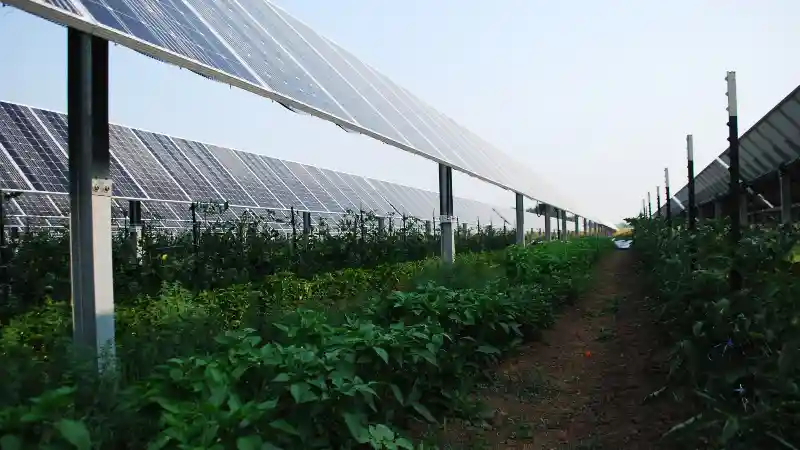Agrivoltaic Farms – Farming meets green electricity production
Recently, there has been a lot of noise in the media about solar farms “threatening” UK farmland.
Politicians have been using these claims to tussle with their opponents, tarnishing the public’s perception of both solar power and farming in the process– ignoring their synergetic co-existence!
In this article, we introduce you to Agrivoltaics: the practice of harmoniously using farmland for both electricity production and farming.
Contents
- What are agrivoltaic farms?
- What is the origin of ‘agrivoltaics’?
- What are the different types of agrivoltaic farms?
- What decides the viability of an agrivoltaic farm?
- What are the advantages of agrivoltaics?
- Are agrivoltaic farms the best use for solar panels?
- Are there agrivoltaic farms in the UK?
- FAQs
What are agrivoltaic farms?

In agrivoltaic farms, solar panels are installed alongside crops and/or herding fields to generate both farming produce and solar power for use within the property or to be sold to a local or national grid.
The idea is to synergise both activities and make optimal use of sunlight, which is the primary resource sought for energy production or photosynthesis.
💡 Agri is derived from “agriculture”, while voltaics comes from the “photovoltaic effect” which is what solar panels use to convert solar radiation into useful electricity. Other names for this technology include agrophotovolatics, agri-solar or dual-use solar.
What is the origin of ‘agrivoltaics’?
Agrivoltaics originated soon after solar panel technology became commercially available in the 1970s-1980s. The oil crisis of that period incentivised both farmers and energy investors into deploying the new technology at scale in rural areas, vying for cheaper electricity.
As a way of reconciling the differences between both parties, academics started looking into implementing solar panels alongside traditional and mechanised agriculture, giving birth to ‘agrivoltaics’ as an academic niche within technological institutions such as the Fraunhofer Institute of Solar Energy Systems.
This dual approach to the use of rural land became dormant for many decades after fossil fuel prices dropped back to background levels, and it would take another 30 years before the term “agrivoltaic” would be mentioned in this 2011 paper.
As the realities of climate change have finally sunk in, there is a renewed interest in agrivoltaic farming as a 21st-century approach to generating green energy while improving the management of productive land.
What are the different types of agrivoltaic farms?
The main way to distinguish between agrivoltaic farms is through the arrangement of the solar arrays, of which there are three major variations:
Spaced arrangement
In this variation, solar PV arrays are spaced out to leave wide gaps between rows, leading to alternating shaded and sunlit areas in the land.
Not only does this incentivise a healthier type of agriculture with more crop and animal species per area, but it also leaves predictable areas that are sheltered from wind, rain and even frost.
Stilted arrangement
Here, solar PV arrays are lifted from the ground with stilts, leaving ample protected space under the panels to accommodate larger crops and animals that prefer limited exposure to sunlight, water and frost.
This is particularly helpful in areas with excessive heat or lack of rainfall, as these sheltered areas can be a temperature regulation and water retention haven.
Roofed arrangement
As the name suggests, solar PV arrays are fixed the rooftop of greenhouses or barns to provide electricity for these structures. This is particularly useful at higher latitudes as the electricity can be used for lighting and heating, especially when the panels are combined with solar batteries.
💡 These three varieties of agrivoltaic arrangements are often used simultaneously depending on the requirements of each farm. Also, expect new arrangements to come into place as new technologies like perovskite cells and flow batteries start getting traction.
What decides the viability of an agrivoltaic farm?
There are both human and physical factors that determine the success of an agrivoltaic project.
Human factors
Legislation
National, regional and local regulation may be problematic as energy generation and farming are two contrasting activities. However, an urge to decarbonise is leading to favourable changes in the rules that dictate agrivoltaics, the TEC Amnesty in the UK being a good example of bureaucratic streamlining to favour renewable business energy.
Public Opinion
Renewable energy is rather unpopular with some segments of the population, and unfortunately, many local farmers are of this opinion. This is exemplified by the recent political debacles against ground-based solar, despite it being a potential alternative revenue stream in rural areas.
Fortunately, solar innovations are bringing inconspicuous types of solar power that blend in with the landscape, preventing unwanted attention.
Subsidies and Incentives
It’s in the country’s interests to increase their low carbon energy generation capacity, and countries like the Netherlands, Germany and now the US are providing subsidies and incentives to accelerate the roll-out of solar power.
Many of these apply to rural areas and can make agrivoltaic farms potentially lucrative ventures.
While less notable, the UK government also had multiple mechanisms to support both small and large agrivoltaics in the form of:
- Favourable financing (green loans and leases) for farms.
- Streamlined applications for community renewable projects.
- Contracts for Difference (CFDs) that guarantee a minimum price for utility-scale solar power.
- Renewable Energy Guarantees of Origin (REGOs) add a premium to each MWh produced.
- Corporate Power Purchase Agreements (PPAs) that help agrivoltaic farms get long-term deals for their power.
- Business energy grants
Feed-in-Tariffs
Many governments around the world have different mechanisms for selling electricity back to the grid (i.e. Feed-in-Tariffs).
The UK used to have its own Feed-in-Tariff scheme but this was recently replaced by the Smart Export Guarantee (SEG) which enables domestic and business energy suppliers to purchase electricity generated by small agrivoltaic PV systems.
💡 Larger agrivoltaic projects (utility-scale) must rely on CfDs and PPAs to export their electricity back to the grid. See this map of solar power generators in the UK (many of them agrivoltaic farms!)
Physical factors
Sunlight intensity
Agrivoltaic farms (like any solar power projects) favour areas with ample sunlight resources, like Southern Spain, Greece or Australia.
However, the plummeting price of solar panels (80% decrease since 2010), improvements in energy storage technologies, and rising business electricity prices are making agrivoltaic projects viable in areas with inferior resources like the UK.
The fact that The Netherlands and Estonia have some of the fastest growing solar power capacities in Europe stands as a testament to this decoupling.
Terrain
The accessibility, stability and steepness of the land is also crucial. Not only does it determine the most suitable farming activities determines the ideal arrangement of the photovoltaic systems.
The land’s access to grid connectivity is also crucial to determine how an agrivoltaic project will pay back for its investment.
What are the advantages of agrivoltaics?
Solar panel installation on farmland brings numerous advantages regarding farming and risk management opportunities.
It can improve both agriculture and animal farming by synergetically providing temperature regulation, moisture retention, shade and cheap electricity for heating.
In terms of the project’s ROI (return on investment), installing commercial solar panels may bring a reliable base source of income to a farm’s often unpredictable earnings, which are heavily reliant on unpredictable weather and other natural factors that climate change and biodiversity loss are worsening.
Below, we touch on each of these in more detail.
Temperature and Moisture Regulation
Photovoltaic systems work optimally at cool temperatures (between 15C and 35C), so installing them over crops with temperature-regulating properties actually keeps them cooler and more efficient than if installing them over barren land.
And this works synergetically with crops in the sense that panels also provide a moisture lid that prevents extreme water loss during times of drought or heat waves (which are becoming increasingly common with climate change).
This is particularly effective in a stilted agrivoltaic arrangement, where panels provide shade during the day and capture moisture that condenses on its rapidly cooling surface at night, dripping water back into the soil, forming a closed water loop.
Moisture-absorbing hydrogels can enhance this moisture-retaining cycle by absorbing and collecting the condensed water for targetted irrigation (while keeping the panels even cooler and more efficient!).
Pilot projects using stilted panels in California have shown promising results by successfully growing shade-loving crops such as cucumbers, lettuce, kale, and broccoli with less water, while experiments in Arizona have shown that agrivoltaic systems in aris environments can help save up to 50% of water usage.
💡 The same principle is applied to floating solar panels where an underlying body of water keeps the solar cells cool and efficient. This works synergetically in farm water reservoirs by reducing water loss through evaporation while generating power.
Shade
The shade and protection from the elements provided by solar panels may be a valuable resource for grazing animals during heat waves and inclement weather.
In return, grazing animals like sheep can keep tall grasses from interfering with the panel’s sun exposure by grazing, reducing the need for additional maintenance costs.
Plants also have a maximum amount of photons they can absorb for photosynthesis, which means that much of the sunlight in agricultural land is actually surplus to requirements.
Dynamic agrivoltaics, developed in Japan by Akira Nagashima, leverages this concept by using a system of portable solar PVs that are rotated to cover different crops at different times of the year and maximize yields based on their optimal sunlight exposure.
Additionally, this project in Canada has been using the panel’s shade to grow flowers to support pollinator populations and for beekeeping.
Dual-revenue
Farms that combine agriculture with solar power generation effectively diversify their income and hedge against the risk of catastrophic loss to their principal activity (droughts, natural hazards, plagues, fires, etc).
This energy resilience is of growing importance in climate change adaptation– there is certainty from the scientific community that global weather will become more extreme and unpredicable over time, making farming revenue equally unreliable.
Unlike crops and animals, solar panels are much less sensitive to weather extremes and even geopolitical factors– wars, drought, and economic crises don’t prevent the sun from shining!
Interestingly, the reverse also applies to existing solar farms without a secondary revenue stream. Introducing farming activities that don’t affect the solar resource of the panels is simply making better use of the land.
Activities such as beekeeping, and raising sheep don’t affect solar energy production and can be a small hedge to the unpredictability of the energy market: The UK government is becoming infamous for doing U-turns on its renewables policy.
Are agrivoltaic farms the best use for solar panels?
Solar panels’ cost, adaptability and modularity have made them a popular solution for decarbonising electricity production.
However, solar panel production is limited and has a carbon and water footprint, so some argue they should be placed where they make the highest impact.
Some would argue that solar panels are best suited to the unused parts of the built infrastructure to produce energy near where it is most needed and without causing visual pollution or interference with productive land.
Others argue that floating solar power is an overall more efficient use of panels as the underlying water body regulates temperature while the panels help retain the reservoir’s water used for drinking, agriculture, hydropower, etc.
However, it is clear from this article that there is also much utility within agriculture, particularly in regions of high solar irradiance and water management issues.
Also, some governments make this practice easier by means of government subsidies and feed-in-tariff schemes (Also known as Smart Export Guarantees in the UK) and legislative conditions.
Also, developing transparent PV glass may shift the debate as it enables tailored use of the incoming solar frequencies not needed for photosynthesis to produce energy and make energy-producing greenhouses.
Are there agrivoltaic farms in the UK?
An extensive Google search suggests that, at present, there are no purpose-built agrivoltaic farms in the UK.
However, solar panels are ubiquitous in UK farmland, particularly greenhouses, to power electrical heating in winter or mounted on barns/stables to power lighting and heating.
Also, the University of Greenwich is developing agrivoltaic greenhouses that use transparent PV glass to produce electricity while letting photosynthesising radiation through.
FAQs
Is Sundrop Farms in Australia an agrivoltaic project?
No. Technically speaking, agrivoltaic farms utilise solar PV panels in tandem with farming to synergise both.
Sundrop farms uses Concentrated Solar Power (a solar heating technology) to desalinate water for greenhouse agriculture in the arid desert of Southern Australia, it does not use solar panels.
However, both are incredible solar power innovations that show the fantastic potential of solar power.

